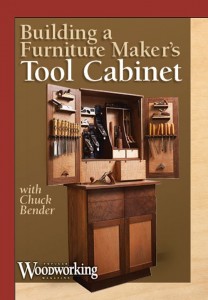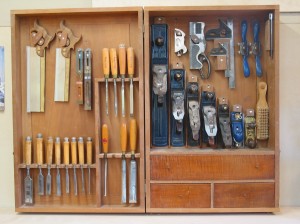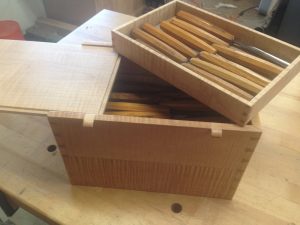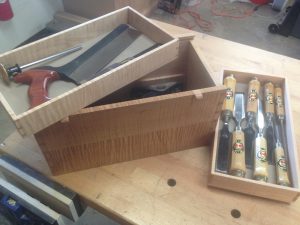We may receive a commission when you use our affiliate links. However, this does not impact our recommendations.
 I got an e-mail the other day letting me know that my new DVD, “Building a Furniture Maker’s Tool Cabinet,” had finally arrived in the shopwoodworking.com warehouse. The e-mail also asked if I’d be willing to write something about the project here on the Editors’ Blog; obviously I said yes. This DVD is the first in a series of compilation videos that contain episodes from my “No BS Woodworking” show. In fact, the tool cabinet was the first project I did for the show (the upper cabinet was made at the beginning of the season and the lower at the end).
I got an e-mail the other day letting me know that my new DVD, “Building a Furniture Maker’s Tool Cabinet,” had finally arrived in the shopwoodworking.com warehouse. The e-mail also asked if I’d be willing to write something about the project here on the Editors’ Blog; obviously I said yes. This DVD is the first in a series of compilation videos that contain episodes from my “No BS Woodworking” show. In fact, the tool cabinet was the first project I did for the show (the upper cabinet was made at the beginning of the season and the lower at the end).
Now that I’ve joined the Popular Woodworking Magazine team (you can subscribe to the magazine here) I haven’t been producing additional episodes of the show because it makes sense to focus on producing content for the magazine and this blog. That doesn’t mean there isn’t good woodworking information to be had by watching the DVD; it just means I now have a broader delivery system with which to expand the information presented in the show/DVDs.
The idea of the tool cabinet actually came from Glen D. Huey, and has turned out to be one of my favorite projects from the show. Maybe that’s because I use the cabinet daily but, realistically, I think it’s because the subject – care, storage and accessibility of our tools – is near and dear to all woodworkers. I already had a tool cabinet. In fact, I used it in the opening sequence for the show. The old cabinet was modeled after a portable tool box that Werner Duerr (the German master who taught me woodworking in high school) had designed as an exercise for senior-level cabinetmaking students.
The old cabinet was modeled after a portable tool box that Werner Duerr (the German master who taught me woodworking in high school) had designed as an exercise for senior-level cabinetmaking students.
Werner’s version was meant to be carried like a suitcase (he created locking mechanisms to keep things from shifting during transport); mine hung on a wall. His design held fast the basic tools a journeyman cabinetmaker needed on a jobsite, and mine was designed to hold the tools well enough that a casual bump wouldn’t send them all flying across the shop floor.
The major problem with my cabinet was that I had outgrown it before I completed it. None of my files and rasps were in the box, and I had an entire rack of screwdrivers and other miscellaneous tools that, unless I wanted remake the cabinet, lived outside the box. Considering I was just starting out, I would likely outgrow a remake before that got finished as well.
While planning for the online show Glen suggested I make something portable but, I wanted something that would be all-encompassing. The idea was to have a permanent place to store my tools while allowing for some transportability. It also meant that I could rework the design of my original box and get all my tools under one roof, as it were.
 I liked the accessibility my old box provided, but something a little bigger would give me more flexibility. I increased the overall size a bit, then began laying out my hand tools in a way that made sense to me for the way I work. In the space where the original cabinet had drawers, I decided on removable boxes with sliding lids and removable trays. I never really liked the way the long top drawer in my old cabinet contained an ever-entangled pile of carving tools.
I liked the accessibility my old box provided, but something a little bigger would give me more flexibility. I increased the overall size a bit, then began laying out my hand tools in a way that made sense to me for the way I work. In the space where the original cabinet had drawers, I decided on removable boxes with sliding lids and removable trays. I never really liked the way the long top drawer in my old cabinet contained an ever-entangled pile of carving tools.
The first tool tote in the new box would house all my carving tools; four removable trays allowed for some expansion (although that is an unlikely need after 30 years of carving with the same tools). 
Considering I was still on the road a bit doing woodworking shows and events, I also wanted to include a tote of basic tools. This way, when it was time to head out and demonstrate how to cut Bermuda dovetails or I needed to put new hinges on a door in the house, I could grab a tote and go.
The second tote contains a set of chisels, and a square, marking gauge, bevel, dovetail saw, mallet, block and smooth planes, in addition to a tape measure and extra room for a small jeweler’s saw.
The idea was to create a cabinet for the tools I had and the tools I thought I’d be adding, and to store them in a manner that let’s me work the way I want. It’s all about customizing my tools and their storage to meet my needs and desires.
If I had to pick out the single-most important lesson from the DVD, it would be to make the tool cabinet your own. Look at the tools you have and the things you make with them. Design your cabinet to reflect your aesthetic sensibilities, and make it work for you. Put the tools you use most within reach and make them easy to grab.
In thinking about this project as I write this post, it occurs to me the reason it’s one of my favorite projects is because it’s uniquely personal to me. In the end, whether you’re a tool cabinet woodworker or not, the place where you keep your tools is really just another tool in your arsenal.
Here are some supplies and tools we find essential in our everyday work around the shop. We may receive a commission from sales referred by our links; however, we have carefully selected these products for their usefulness and quality.









The thing about tool chests, boxes, cabinets or whatever form they take is that they buffer the tools from temperature and humidity changes and from dust. That goes a long way toward inhibiting rust.
Very nice. I’m not sure if it’s “cool woodworker” nice, but I would love to have one.